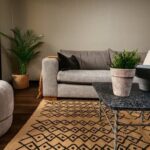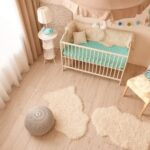Are you looking to add a personal touch to your home decor? A home decor sewing machine can be an essential tool for bringing your creative ideas to life. From decorative pillows to custom curtains, a sewing machine opens up endless possibilities for transforming your living space.
Sewing machines play a vital role in home decor, allowing DIY enthusiasts and interior design aficionados alike to create unique and personalized pieces that reflect their style and taste. Whether you’re a beginner or an experienced seamstress, having the right sewing machine is crucial for successful home decor projects.
In this article, we will explore the importance of sewing machines in home decor, as well as provide valuable tips on choosing the right machine for your needs and setting up a functional workspace. We’ll also cover essential sewing techniques, must-have accessories, and provide step-by-step guides on creating decorative pillows and custom curtains.
Whether you’re looking to add embroidery or applique details to your projects, we’ve got you covered. So get ready to elevate your home decor with the help of your trusty sewing machine.
Choosing the Right Sewing Machine for Home Decor Projects
When it comes to home decor sewing projects, choosing the right sewing machine is crucial for achieving professional-looking results. There are a variety of factors to consider when selecting a machine that is suitable for home decor tasks.
Firstly, it’s important to look for a sewing machine that offers a wide range of decorative stitches and embroidery options. These features will allow you to add intricate details and patterns to your home decor items such as pillows, curtains, and table linens.
Another important factor to consider when choosing a sewing machine for home decor projects is the type of fabric you plan to work with. Heavier fabrics such as upholstery material or thick drapery fabric may require a more powerful sewing machine with a sturdy needle and feed dog system.
Additionally, if you plan on working with delicate fabrics like silk or chiffon for your home decor projects, look for a machine with adjustable tension settings and a smooth fabric feed system.
To ensure that your chosen sewing machine will meet all your home decor needs, take some time to test out different models before making a purchase. Consider bringing samples of the fabrics you plan on using for your projects to see how each machine handles them. This hands-on approach will help you make an informed decision when selecting the right sewing machine for your home decor endeavors.
| Feature | Description |
|---|---|
| Decorative Stitches and Embroidery Options | Look for a sewing machine that offers a wide variety of decorative stitches and embroidery options for adding intricate details. |
| Fabric Compatibility | Consider the type of fabrics you will be working with and choose a machine that can handle both heavy materials and delicate fabrics. |
| Hands-On Testing | Before making a purchase, bring fabric samples to test out different sewing machines to ensure they meet all your home decor needs. |
Tips for Setting Up Your Sewing Machine Workspace
When it comes to creating beautiful home decor with your sewing machine, having a well-organized and functional workspace is essential. The right setup can make all the difference in the success of your projects. Whether you have a dedicated sewing room or a small corner of a room to work in, there are some tips that can help you make the most of your space.
First and foremost, it’s important to have a sturdy table or desk for your sewing machine. This will provide a stable surface for sewing and prevent any unnecessary movement while you work. Additionally, having good lighting is crucial for accurate stitching and avoiding eye strain. Consider adding task lighting or using natural light to illuminate your workspace.
Organizing your tools and supplies is another important aspect of setting up your sewing machine workspace. Invest in storage solutions such as bins, baskets, and shelves to keep everything easily accessible and tidy. Having a designated spot for your threads, scissors, pins, and other notions will save you time and frustration during your projects.
Lastly, consider the ergonomics of your workspace. Adjusting the height of your chair and table to ensure proper posture can prevent discomfort or injury during long hours of sewing. It’s also helpful to have an ironing board nearby for pressing seams and fabric before stitching. By following these tips for setting up your sewing machine workspace, you can create an environment that promotes creativity and productivity for all of your home decor projects.
Essential Sewing Techniques for Home Decor Projects
When it comes to home decor sewing projects, mastering essential sewing techniques is key to achieving professional-looking results. Whether you’re creating custom curtains, decorative pillows, or unique embroidery and applique designs, understanding these fundamental sewing techniques will help elevate your home decor to the next level.
Straight Stitching and Backstitching
One of the most basic yet essential sewing techniques for home decor projects is the straight stitch. This stitch is ideal for joining fabric pieces together, hemming edges, and creating clean lines in your projects. To ensure durability, it’s important to utilize backstitching at the beginning and end of your seams. This technique involves stitching backward and then forward over the same stitching line to lock the stitches in place.
Topstitching
Topstitching adds a professional finish to your home decor projects by providing a decorative element while also securing layers of fabric in place. This technique involves stitching a visible line on the right side of the fabric, typically 1/8 inch to 1/4 inch from the edge. Topstitching can be used to accentuate seams, create decorative borders on pillows and curtains, and add structural details to various items such as table linens or upholstery.
Blind Hemming
For creating polished hems on draperies, curtains, and tablecloths, mastering the blind hemming technique is essential. This technique allows you to conceal the raw edge of the fabric while creating a nearly invisible seam from the right side of your project. Using a blind hem foot attachment on your sewing machine can simplify this process and ensure consistent and precise results in your home decor sewing projects.
By mastering these essential sewing techniques for home decor projects, you’ll be well-equipped to take on a wide range of sewing tasks with confidence and skill using your home decor sewing machine.
Must-Have Sewing Accessories for Home Decor Enthusiasts
When it comes to sewing for home decor, having the right accessories can make all the difference in the outcome of your projects. Whether you’re a beginner or an experienced enthusiast, investing in these must-have sewing accessories will not only make your sewing process more efficient but also elevate the quality of your home decor items.
Rotary Cutter and Cutting Mat
One accessory that every home decor sewing enthusiast should have is a rotary cutter and cutting mat. This tool allows for precise and clean cuts on various fabrics, making it essential for projects like creating custom curtains, draperies, and decorative pillow covers. With a sharp rotary cutter and a self-healing cutting mat, you can say goodbye to uneven edges and jagged seams.
Quality Thread
Using the right thread is crucial for achieving professional-looking results in your home decor sewing projects. Investing in high-quality thread in a variety of colors will ensure that your stitches are durable and blend seamlessly with your chosen fabric. When it comes to home decor items like curtains and throw pillows, the last thing you want is for the thread to break or stand out against the fabric.
Pressing Tools
Another important set of accessories for home decor sewing are pressing tools. A good steam iron and ironing board are essential for achieving crisp seams and professional-looking finishes on your projects. Additionally, consider investing in a tailor’s ham and sleeve roll to aid in pressing curved or detailed areas such as pillow corners or pleats in draperies.
By equipping yourself with these must-have sewing accessories, you’ll be better prepared to take on a wide range of home decor projects with confidence and precision using your trusty home decor sewing machine.
Step-by-Step Guide to Sewing Decorative Pillows
Decorative pillows are the perfect way to add a pop of color, texture, and personality to any room in your home. With the right fabric and a quality home decor sewing machine, you can create custom decorative pillows that will elevate the style of your living space. In this step-by-step guide, we will walk you through the process of sewing decorative pillows so that you can enhance your home decor with your own unique creations.
First, you’ll need to gather your materials. Choose a durable fabric for the pillow cover that complements your existing decor. Consider using a variety of textures and patterns to add visual interest. You’ll also need pillow inserts or stuffing material, thread that matches your fabric, pins, scissors, and of course, your trusty home decor sewing machine.
Once you have all your materials ready, it’s time to measure and cut your fabric to the desired size for your pillows. For a standard square pillow, this would typically be 1-2 inches larger than the actual size of the pillow insert to account for seam allowances.
Next, pin the fabric together with right sides facing each other and sew around three sides of the fabric using a straight stitch on your sewing machine, leaving one side open for inserting the pillow form.
After sewing the three sides together, turn the fabric right side out and insert the pillow form into the cover. Then neatly hand-sew or use your sewing machine to finish closing up the open side with an invisible stitch or a straight stitch close to the edge. Once complete, fluff up your new decorative pillow and place it on your sofa or bed to enjoy your handmade home decor masterpiece.
Creating Custom Curtains and Draperies With Your Sewing Machine
Curtains and draperies can add the perfect finishing touch to any room in your home. Whether you’re looking for a simple, clean look or something more intricate and decorative, creating custom window treatments with your home decor sewing machine can help you achieve the exact style you want. Here are some steps to get started on making your own custom curtains and draperies:
1. Measure your windows: Before you begin sewing, it’s important to measure your windows accurately. Consider the length and width of the curtains or drapes you want, as well as any additional fabric needed for hems and rod pockets.
2. Choose the right fabric: Select a fabric that not only complements your existing decor but also suits the purpose of the room. For example, heavy fabrics like velvet or brocade work well for formal spaces, while lighter fabrics such as cotton or linen are great for a more casual setting.
3. Sewing techniques: Depending on the style of curtain or drapery you’re making, there are several sewing techniques you may need to use. For example, basic straight stitching for hemming, gathering or pleating for creating fullness, and adding lining for extra privacy and insulation.
4. Personalization: Once the basic construction of your curtains or drapes is complete, consider adding personal touches with embroidery or applique using your home decor sewing machine. This can help tie in the window treatments with the overall theme of your space.
By following these steps and putting in some time and effort, you can create beautiful custom curtains and draperies that perfectly suit your home decor needs using your home decor sewing machine.
Personalizing Your Home Decor With Embroidery and Applique
Embroidery and applique are two popular ways to personalize your home decor and add a unique touch to your space. With the right sewing machine, you can easily create customized items that reflect your personal style. Here are some tips and techniques for using embroidery and applique in your home decor projects:
- Choose the Right Thread: When working on embroidery or applique projects, it’s important to use the right type of thread. Embroidery thread is typically thicker and has a sheen to it, while applique thread is often used for securing fabric pieces in place.
- Selecting Fabric: Different fabrics work better for embroidery and applique. For example, lightweight cotton or linen are great choices for embroidery, while medium-weight fabrics like canvas or denim work well for applique.
- Mastering Stitches: There are various stitching techniques you can use for embroidery, such as satin stitch, chain stitch, and running stitch. Applique involves stitching fabric pieces onto a base fabric using a zigzag or blanket stitch.
Adding embroidered details to throw pillows, table linens, and wall art can instantly elevate the look of your home decor. You can also use applique to create custom designs on curtains, lampshades, and even upholstered furniture. With the right tools and skills, you can transform ordinary household items into one-of-a-kind pieces that showcase your creativity.
Recommended Embroidery Sewing Machines
- Bernina 790 Plus
- Brother SE600
- Singer Quantum Stylist 9960
In addition to investing in a high-quality sewing machine that offers embroidery capabilities, consider purchasing an assortment of embroidery hoops, stabilizers, and applique templates to further enhance your home decor projects. By incorporating personalized embroidery and applique designs into your living space, you can truly make it feel like home.
Maintaining and Troubleshooting Your Home Decor Sewing Machine
As with any tool, it’s important to properly maintain and troubleshoot your home decor sewing machine to ensure that it continues to function at its best. Regular maintenance will not only prolong the life of your machine but will also help to prevent any issues from arising during your sewing projects.
One of the most important aspects of maintaining your sewing machine is to keep it clean. Dust, lint, and thread scraps can build up inside the machine and cause it to jam or run less efficiently. Be sure to regularly remove the bobbin case, needle plate, and feed dogs to thoroughly clean out any debris. Additionally, oiling your sewing machine as recommended by the manufacturer will keep all moving parts running smoothly.
In addition to regular maintenance, it’s also essential to troubleshoot any issues that may arise with your home decor sewing machine. If you notice that the stitches are uneven or skipped, it could indicate a problem with the tension or needle.
Taking the time to troubleshoot these issues and make any necessary adjustments will ensure that your sewing projects turn out beautifully. By staying on top of maintenance and troubleshooting, you can rely on your home decor sewing machine for years to come.
Conclusion
In conclusion, investing in the right sewing machine can truly transform your home decor. Whether you’re a beginner or an experienced enthusiast, the right machine can make a world of difference in the projects you take on and the results you achieve. By carefully choosing the right sewing machine for home decor projects and setting up a well-organized workspace, you can ensure that your sewing experience is both enjoyable and productive.
With essential sewing techniques, must-have accessories, and step-by-step guides for projects like decorative pillows and custom curtains, your home decor sewing machine can help you bring your design ideas to life. Additionally, the ability to personalize your creations with embroidery and applique adds a unique touch to your home decor that store-bought items simply cannot match. With proper maintenance and troubleshooting knowledge, you can keep your machine running smoothly for years to come.
Ultimately, with the right tools and skills at your disposal, there’s no limit to what you can create for your living space. Your home decor sewing machine has the power to elevate the look and feel of any room in your house, allowing you to express your creativity while also adding practical touches to enhance your everyday life.
Whether it’s adding custom throw pillows or crafting one-of-a-kind window treatments, the possibilities are endless when it comes to transforming your living space with a quality home decor sewing machine.
Frequently Asked Questions
Which Is Best Sewing Machine for Home Use?
The best sewing machine for home use depends on the needs and preferences of the user. Some popular options for home use include computerized machines with a variety of built-in stitches, as well as heavy-duty machines for those who work with thick fabrics.
What Type of Sewing Machine Is Use for Home and Personal Use?
For home and personal use, a basic mechanical sewing machine is often sufficient. These machines are easy to use and maintain, making them perfect for everyday sewing tasks like mending clothes or simple crafting projects.
What Is the Best Sewing Machine to Make Curtains?
When it comes to making curtains, a sewing machine with features like a longer throat space, adjustable presser foot pressure, and a variety of decorative stitches can be beneficial. Machines with these features can help create professional-looking curtains with clean, even seams and decorative details.

I’m thrilled to be your companion on this exciting journey through the world of home decor and design. With a passion for turning houses into homes and a keen eye for the finer details, I’m here to help you transform your living spaces into beautiful, functional, and meaningful havens.





